FAQs About Soft/Shell Rot, Conditions In
Turtles 7
Related Articles: Shell Rot in Turtles, Treating Common Illnesses of
the Red Ear Slider (& other Emydid Turtles) by Darrel
Barton, The
Care and Keeping of the Red Eared Slider, Trachemys scripta elegans by Darrel Barton, Red Ear Sliders, Turtles, Amphibians, Red Eared Slider Care,
Related FAQs: Shell Rot 1, Shell Rot 2, Shell Rot 3, Shell Rot, Conditions 4, Shell Conditions 5, Shell Conditions 6, Shell Conditions 7, Shell Conditions 8, Shell Conditions 9, Shell Conditions 10, Shell Conditions 11, Shell Conditions 12, Shell Conditions 13,
Shell
Conditions 14, Shell Conditions
15, Shell Conditions 16,
Shell Conditions 17,
& Turtles, Turtles 2, Turtle
Identification, Turtle
Behavior, Turtle
Compatibility, Turtle
Selection, Turtle Systems,
Turtle Feeding, Turtle Disease, Turtle Disease 2, Turtle Disease 3, Turtle Reproduction, Amphibians, Other Reptiles,
|
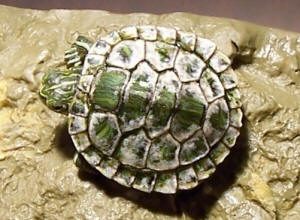
|
Red Eared Slider shell -- 12/27/09
Dear Crew,
<Hiya -- Darrel here>
I read through all the questions about red eared sliders and shell
problems but can't seem to find one that fits mine. My red eared
slider has white lining the back and a very small amount on the side.
It is not small circles but it looks more like one line that is a cm
thick curving around the back of his shell. I don't know if
it's shedding or shell rot or what to do about it.
<Brit -- it could just be mineral buildup from the water. I've
even seen water spotting create lines like that. Take him (or her) out,
dry him off and then use a Q-Tip and some vinegar and gently scrub the
line. It may take several minutes and a few drops of the vinegar, but
attempt to rub a section clean. Minerals will come off like dirt on the
swab, water spots will simply disappear and fungus will come off in
irregular shreds. Also, while there, take a really good look to see if
it's the upper layer of the scute separating in preparation to shed
(that's natural).>
<Failing that, a picture -- even if shot with a camera phone --
might give us more to go on. Meanwhile, this is a good time to go over
every aspect of your care and keeping and find anything not up to
standard. Sometimes, by identifying something we're doing wrong we
can deduce what an ailment is>
read:
http://www.wetwebmedia.com/FWSubWebIndex/RESCareBarton.htm>
Teenage Mutant Parasitic Turtles?
12/20/09
Hello there again!
<Hiya back. Again. Darrel here. Again.>
Good to hear you know who you are, I feel I am in a perpetual state of
identity crisis--like déjà vu meets twilight
zone.
<Remember .. just because you're paranoid doesn't mean
they're not out to get you!>
And yes, I am easily amused, with someone who is amusing, which you
definitely are!
<People describe me as 'funny' but they're not laughing
when they say it '¦.>
I am rarely offended, and find that people who are easily offended do
not amuse me at all!
So...
Sorry it took so long to write back to tell you thank you for your
quick reply!
<I'm fast, just not usually accurate>
I separated all creatures as per your desperately difficult demands in
your aforementioned email, and, the fishies are all carcass eating
disease free (or, seem to be, because they have grown back quite a bit
of carcass and seem hole-less as of late) !
<Fish without missing body parts are happier. We have metrics on
that>
My turts um, I think they are good? the scrapeish (not a word, but
should be because I feel it adequately describes the issue) thing on
the one's back seems to have healed, but is still visible, but not
green, and is hard and shell like now instead of mushy-ish. I dosed
them in the salt water mix as you said, and they shed all of their
scutes... I hope that was supposed to happen. the salt seemed to dry
them and force scutes off...
I dunno.
<Likely you helped the shed layers off>
but, they are swimming happily again... however, they haven't eaten
in like 2 weeks...and I assumed because they were stressed out from
being transferred and treated... I am about to put them back into their
old tank, (hopefully now parasite free, because DANG that was ALOT of
WORK!!!!!) and I am hoping that once they are back "home" and
can swim and climb on their favorite cinder block, that they will
resume eating more like piglets and less like anorexic teenage mutant
turtles!
<If they didn't eat during their daily baths, it may take a
while to get them started again. If you don't see eating behavior
in the first week, try tempting them with live earthworms>
Oh and no DANGLING PARTICIPLES...
Dangling feces yes, from the fish, THAT is a pet peeve of mine.
Though it's a pet I do not feed, as I do all other pets of mine.
But I do not care for peeves.
Peeve. Haaaa haaaa haa.
oh and dangling things in general I find inappropriate. things
shouldn't dangle.
ew.
ANYWAY!!!
my hopes are that my turts will be happy and healthy again and living
it up in their newly cleaned tank by Christmas. yeah, it shoulda been
before now, but I've been working mondo overtime, and my jeep ate a
fence, so therefore everything in my life is way behind schedule.
<the JEEP ate the fence? It's a poor musician that blames her
instrument>
Thanks again for your entertaining answers to all my scrapish dangling
turtles needs!
Merry Christmas!
I hope Santa doesn't dangle from your chimney with a fat belly.
(was that a dangling participle? <Or a misplaced modifier>
I was trying, though I am normally so correct in using the English
language that I was struggling with that one. WAH HAAA!)
Glad tidings of purple cheer which shall be to all people wearing Santa
hats with beards.
later gator!
Rachael !
RES with algae on shell? 12/13/09
Dear WWM Crew,
I have searched your site (very nice! and quite informative) and the
internet, but I can't seem to find the information that I'm
looking for. I hope that you can help me.
I have a red-eared slider that I purchased in Sept. this year, as a pet
for my kids. He appears to be healthy, happy (as long as I feed him in
the tank) and he's about 4 1/2 inches. Last week I noticed a couple
of dark green/bluish green spots on the edge of his shell. At first I
thought he might have injured his shell as he likes to dive off his
turtle dock (he displays the typical RES dislike for spectators when
basking) and he sometimes crashes into the side of the aquarium. But on
closer observation and after 1 week+ time, the shell appears to be
intact and unharmed, just
discolored. He also has a couple of spots on his back, and now his
turtle dock has the same color green stuff growing on it.
I suspect it's just algae, which should be fine (right? unless it
becomes excessive?), but I can't find a good photo to check and
see. It's not white, brown, cheesy, or soft on the shell, and while
he did shed (his skin, not his shell) recently, that didn't last
overly long, either, and appeared to me (admittedly a novice) to be
just normal reptile shedding.
Other than being stressed when I take him out to clean his tank or look
him over, he's very sociable and seems happy (good appetite, quite
friendly and curious, etc.) as long as I leave him in his tank. In the
beginning I took
him out of the tank to feed him in the interest of maintaining good
water quality (I wrongly thought that behavioral conditioning with food
motivation would work after time), but he got more and more hostile and
he finally bit me. I finally got the hint and started feeding him in
his tank.
Now he just hisses at me when I take him out of the tank to clean it
every other week, and I just do partial water changes in between, every
few days, which don't seem to upset him as much. I hate to take him
to a vet or probe his shell any more unless there is a real problem, as
he just doesn't like to be messed with.
His setup is unremarkable, except for a couple of minnows which he
seems to enjoy for company and the occasional live plant for a snack.
Sometimes he eats the plants, sometimes he just makes a mess with them.
I offer them about once every couple of weeks and I take them out if he
just steps on them for a couple of days; usually if he is going to eat
them he does so right away, and finishes them completely.
I give him turtle bites, turtle sticks, offer him fresh greens/veggies
(he won't eat them yet), live crickets 1x per week, etc. He has a
turtle tuff full spectrum lamp for basking that supposedly offers the
necessary UVB/etc. His tank is not in the sun, nor is it in a drafty
area.
Sometimes he eats the minnows, but usually he just pals around with
them.
I had him in a 40 gallon breeder, but I'm currently repairing it so
he's in a 20 long at the moment until I can finish sealing the
other tank.
Filtration is a 50gal+ zoomed canister and a reptile canister filter,
with partial water changes every few days. The water looks very
clear.
Thanks so much. I've learned so much about turtles in the past few
months - I had no idea that they were such sociable and fascinating
creatures. I think I spend a lot more time watching him than my kids
do...
Angela Hirte, D.M.A.
(Unfortunately my doctorate is in music, not medicine or veterinary
medicine)
<Angela, it sounds like you're looking after this terrapin very
well. Algae is distinctive, and if you wipe it with a paper tissue
(like kitchen roll) it comes off easily, and you should notice a green,
often dark green, colour. Whereas fungus isn't coloured and has a
distinctive smell, algae tends to be odourless. Blue-green algae
(actually bacteria) is musty, and looks more like matted fibres, and
usually has a strong colour: red, cyan, dark green, black. In any even,
algae can be simply wiped off as required.
It's not a bad habit to get into. While cleaning the terrapin you
check its overall skin condition, listen to its breathing, and check
its eyes. You can also get the terrapin used to being handled, in
itself a very useful practice, since these animals can become
"biters" otherwise. There's no absolute need to remove
the stuff (in the wild it offers a kind of
camouflage) but it is probably true that a terrapin with a dirty shell
is a bit more likely to have problems with fungal infections because
things like food and dead skin can get trapped. Hope this helps.
Cheers, Neale.>
|
Possible shell rot? 12/5/09
Dear Crew,
<Hiya -- Darrel here>
I sent you an email with some pictures attached yesterday.
<Yes you did>
I am considering purchasing this turtle.
<OK>
I would sincerely appreciate it if you could reply back with your
answer ASAP.
<Be happy to, Mark. Sometimes the problem is that our 'as
soon as POSSIBLE' isn't the same as the writers 'As
soon as I NEED IT'>
<This is a handsome turtle, Mark. Assuming its eating well,
pooping well and active, I'd buy it without
hesitation.>
<Your pictures are well done, properly sized and in focus,
too! These pics serve as an example of what we'd really like
to have when folks send us pictures. Congratulations on
them!>
<That said, I can't tell you if that's a fungus or
not. What I see has some traits of a shell fungus but also some
traits of a worn shell from a turtle that's been in the wild
or in less than perfect water conditions. Believe it or not,
people have brought me turtles looking just like that for a
consultation and it turns out to be nothing but water spots!
What's missing here when the photos are indeterminate is the
smell and texture. Can you scrape some of it off and onto a dull
knife edge? That would indicate a fungus? Does it smell at all?
Same thing -- fungus. But if it's just some damage to the
outer layers of the shell, then it's nothing to concern
yourself with.>
<What I would do is to buy the turtle and then treat him as if
it IS shell rot. A few weeks in a warm dry climate with daily
treatments of the affected area can't hurt him even if
it's just mechanical damage, and if it IS a fungus, even a
minor and superficial one, then you're nipping it in the bud.
Link below>
<Just make sure he's active and eating, clear eyes and
nose before you buy him>
Thank you,
<Yer welcome!>
<Treatment:
http://www.wetwebmedia.com/FWSubWebIndex/treating%20RES%20Dis%20DarrelB.htm>
|
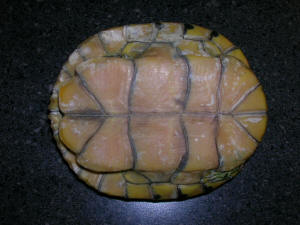 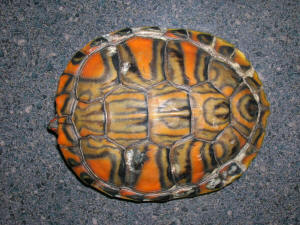
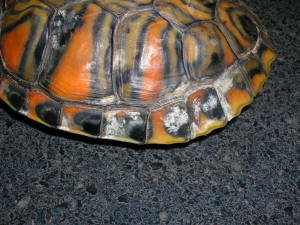 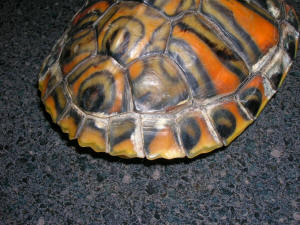 |
|
Soft-Shell Turtle Dying!!!! pls help.
11/22/09
Hi,
<Hiya - Darrel here>
My Turtle is FAMILY: TRIONYCHIDAE (Softshell Turtles) Indian
Flapshell Turtle (Lissemys punctata andersoni). My Turtle's
age is 4-5 years old & its Single Female.
The problem is since last 1 month my turtle eats very small
amount after 2-3 days only & sleeps whole day (is this
because of winter season?)
<That would depend entirely on the conditions and temperature
in her situation>
And also its shell & skin has started pealing off, & its
bottom shell is breaking also...I'm really worried
now...because since last month they are getting worse.
<Yes, these pictures show a turtle in distress>
Here you can see current now Skin** pealing off**,Shell &
bottom shell breakage pictures pics( its Hands & Feet Skin is
getting Extremely Dry day by day):
http://yfrog.com/j793125143jx
<Yes. These pictures show a long term care issue, either diet
or water conditions - or both>
what do I need to do, to help my soft-shell turtle?
<The immediate care is to get her warm and dry. Cover her
sores and skin tears with iodine twice daily and allow them all
to dry thoroughly. I am enclosing a link for care of common
illnesses in Read Eared Sliders and what you should do is follow
the same treatment as for FUNGAL INFECTIONS -- except you'll
need to hydrate her more often.>
<The Trionyx Family are fairly hardy animals, Rehan, but once
they contract a skin disease the outlook is not good. If you can
keep her dry, the ulcerations (sores) washed in peroxide and then
covered in iodine, the skin may have a chance to start to heal
... but unlike an Emydid (hard shelled water turtle) your
Softshell shouldn't have her skin completely dried -- so
you'll need to put her in water twice daily, while at the
same time allowing the iodine to dry over the sores.>
<By keeping her warm & dry (around 80(f) / 27(c)) and then
twice daily into water about the same temperature, you might
stimulate her appetite - which brings us to the other half of the
problem. She appears to be obese ... meaning she's eaten too
much and gotten fat, which can lead to internal organ
deterioration which in turn leaves them open to skin
infections.
Give her a light diet or Koi pellets or Repto-Min food sticks and
very little protein and perhaps after a month or so we might see
improvement.
Best of luck to you>
waiting for your help.
thanks in advance.
<here's the link:
http://www.wetwebmedia.com/FWSubWebIndex/treating%20RES%20Dis%20DarrelB.htm>
|
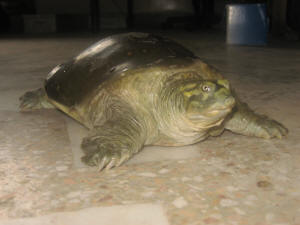 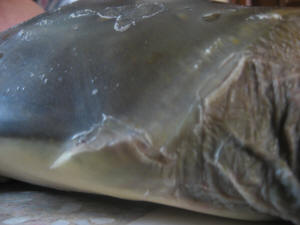 |
RES with white spots 11/3/09
Hi,
<Hiya right back - Darrel here>
I have a 5 inch, male, Red Eared Slider who has lots of white spots on
his top shell. I recently noticed that the spots are spreading. The
white spots have the same hardness as the shell and don't smell bad
or discharge pus.
<Presumably they're not simply mineral deposits, but never rule
that out.
Do they scrub off with an old toothbrush and a tiny bit of soap (very
tiny bit)?>
Also the edges of his shell are turned up slightly and transparent
<That happens as the shell grows and the scutes prepare to shed.
It's normal>
The bottom shell also has one white spot on it. What could this be?
<There's a link below to treating common illnesses and I'd
suggest you read and treat for fungal infection. It's a non
invasive treatment that won't hurt him if it's not
fungus.>
Thanks for helping, Herpgirl
<Yer welcome!>
<http://www.wetwebmedia.com/FWSubWebIndex/treating%20RES%20Dis%20DarrelB.htm
>
|
White stuff in the margins of her shell --
10/9/09
Hi,
<Hiya - Darrel here>
I found a red eared slider about 5 months ago walking down the
middle of my street!
<Don't do that Rhonda! Please use the sidewalks.>
<Oh .. wait ... you meant the TURTLE was walking down the
middle of the street, huh?>
I'm new to turtles and have learned much from your site.
<We like hearing that!>
I thought maybe she might have shell rot, but from what I've
read that is white spots on the shell. My turtle has soft white
stuff in the margins of her shell. She is shedding right now, is
that a normal part of shedding?
How long does a normal shed last?
<The picture you sent appears to be a healthy shell. Believe
it or not, sometimes white spots on the shell or in the margins
is nothing but water spotting!>
<Shedding is normal, as the scutes should become thing and
clear and come off very much like thin fingernails. In the wild
it happens during the summer season but in captivity, without the
seasonal cycles, it will happen sporadically all year
long>
Her diet consists of feeder fish, ReptoMin mini sticks, ReptoMin
baby shrimp and on occasion earthworms and zucchini.
<Skip the feeder fish please -- not part of her natural diet
& notorious for having parasites. Also, Koi pellets are the
same balanced diet only less expensive.>
Her basking area is 80 degrees
<Go for 85-90 degrees, please (see link below)
she has a filter in her tank and I change the water weekly.
<You seem like a great Turtle Mom, Rhonda!>
I've included a picture.
<She's pretty!>
Thank you!
Rhonda
<yer welcome, Rhonda>
Basic Care: http://www.wetwebmedia.com/FWSubWebIndex/RESCareBarton.htm>
|
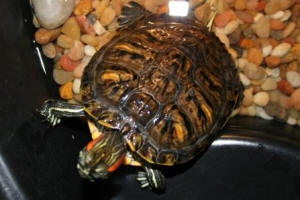 |
Old Red Eared Slider, shell fungus... -
10/06/2009
Hello.
<Hiya - Darrel here>
I have had my Red Eared Slider for eight years now, but before she was
in my possession she lived with my aunt for a few decades, and with
another owner before that.
<That turtle sure gets around>
While her age may have gotten a bit confused as she was passed along,
our current estimate is that she is 41 years old, with at least 35 of
those years being a sure thing.
<I was a sure thing until I was 35, too.>
While she is still healthy, very active and eating well (although she
does have a shell fungus right now, but we are treating that as per
instructions found elsewhere).
<Here's better instructions than found 'elsewhere' --
not saying stop what you're doing, just get a second opinion:
http://www.wetwebmedia.com/FWSubWebIndex/treating%20RES%20Dis%20DarrelB.htm>
She lives in a large washtub, since even a large aquarium was
impractical for a dinner plate sized turtle and we live in a Northern
region with a short, cool summer so an exterior pond was out of the
question. She has a basking area and room for her to swim around a
little, but because she is big it is still a little cramped for her and
we often get her out to wander around the house for exercise. She knows
to return to her tank and sit beside it if she ever gets thirsty or
tired and wants to go home. Anyways, I am wondering if there are any
specific health concerns that I should watch out for in older turtles.
Do their immune systems get weaker or do they develop odd deficiencies?
After a bit of research I found that there does not seem to be much
hard data available on the lifespans of Red Eared Sliders (I found
sites saying everything from twenty to eighty years), but I'm
looking to keep her around as long as possible.
<That's very nice and thoughtful of you, Ian. Generally their
lifespans are environmentally dictated far more than purely
chronological, although I'm going to say that specimens documented
beyond 50 years are rare. As long as the diet is lean (always better to
be a bit hungry than overfed) and the temperature allows for enough
heat to properly digest, the animal will usually go on for years until
some outside influence (fungus, storm or vehicle) overtakes it's
health.>
<What you'll notice in aging animals is an inability (sometimes
it seems like an unwillingness) to properly choose thermal regulation
(won't haul out when it's been in water for two days -- or
won't go in when it's been basking for a few days) combined
with a general listlessness. If/when this happens, it becomes our
responsibility to narrow the ranges (make the water shallow so that
drowning isn't possible, reduce the heat lamp output so that it
can't cook itself, etc.) and usually with helpful measures like
this they can continue in relative happiness for quite a few more
years.>
<If you pay attention to what she seems to want, you'll have a
good idea of what you should do>
|
Red Eared sliders - shells turning orange color --
09/26/09
Hi
<Hiya - Darrel here>
I have 2 red eared sliders since May. In the last week, this
orange discoloration has appeared. It seems slimy and may be a
type of algae. I'm not sure if it's a sign they are
getting sick?
<It's not exactly an algae, it looks more like plain old
slime>
I have Googled, and the only other question about them turning
orange is on your site, but the whole turtle, face, claws, etc.,
were turning orange in that case. My turtles just seem to have it
on their shell. It has just started about a week to 2 weeks ago.
They eat pellets, lettuce, honeydew melon, are very active and I
believe are otherwise healthy. Bask under a warming lamp, and I
have a heater in the tank, water temp about 78, and a filter. I
am attaching 2 pictures.
<The test here is to clean or even scrape some of it off, to
see how easily it does come off. A slime will clean off with a
bit of hydrogen peroxide and a Q-Tip. It won't come
completely off because there is usually some staining, but at
least you'll see a change. The absence of coating on the skin
indicates that it's either not fungal/bacterial --or- if it
is, that you've caught it early. I'm also wondering if
it's a reaction between something in the honeydew (which is
not part of a turtle's diet, by the way) and their UV
lamp.>
<Try scrubbing with a bit of peroxide, cut out the lettuce
& Honeydew, pay strict attention to water quality (remove the
water heater, too) and make sure they're basking area is at
least 90 degrees. Check out the enclosed links for more
specifics>
Teresa Presley
<Care:
http://www.wetwebmedia.com/FWSubWebIndex/RESCareBarton.htm>
<treatment:
http://www.wetwebmedia.com/FWSubWebIndex/treating%20RES%20Dis%20DarrelB.htm>
|
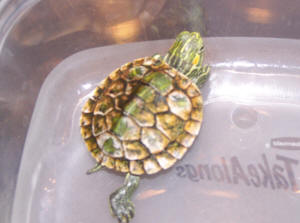 |
|
Re: Red Eared sliders - shells turning orange color
9/29/2009
Hi Darrel,
Thank you for that response. It makes sense, I have just recently
began feeding lettuce and the honeydew, so it makes sense that
may be causing the red coloring. The hydrogen peroxide and cotton
swab did nothing but make the color appear to smear slightly on
the shell. I did take a soft toothbrush and brush the turtles and
the red color came off. I am attaching pictures of them now. The
one that had more reddish on him is now mostly white. I don't
think this white color is fungus, as he was this color when I got
him, I thought from improper care probably. I thought this was
mostly turning back green, but it may have been just
green/reddish, and the red came off and now he's back to the
white. The white color looks sort of like
he scratched off his green color, I don't really know, but at
least the red is gone and I will put him back in their tank and
keep the water super clean, only feeding the pellets, and report
back.
That's Bowser on the top and Mario on the bottom. Mario has
always been much greener than Bowser.
You told me to take the water heater out. Is that because they
are swimming too much and basking too little maybe? They are very
active and stay in the water a lot, but they bask (what I think
is) plenty too.
<We leave the heater out for two reasons, Teresa. First, if
you live south of the Arctic Circle, any room temperature
comfortable for you is fine for them == the point being that we
offer them cool water and warm, dry land and let them choose.
Second, as they get big, the specialize in breaking things &
biting cords ... none of which is good for their long term
health.>
Teresa
<Those are great pics, too. I'm reading about the hand
sanitizers and thinking that by our fairly irrational fear of
germs that aren't really all that bad for us, society is
inadvertently breeding huge, ugly super-bugs
that will do nothing but bring us sickness and disease. Sorta
like by ex -brother in law.>
|

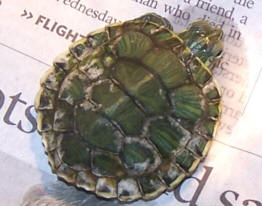 |
|
|

